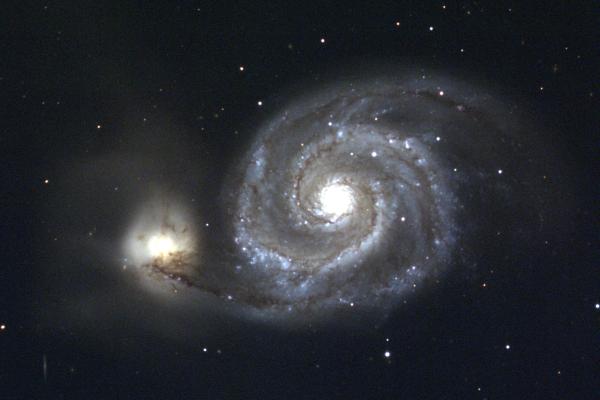
Image 1 Caption: The Whirlpool Galaxy (AKA M51a/NGC 5194 and M51b/NGC 5195) in constellation Canes Venatici (the Hunting Dogs). M51a (the bigger galaxy) is a face-on grand design spiral galaxy.
Features:
- M51 is, as one can see,
two interacting galaxies.
- The larger galaxy
is a SA(s)bc D
(D stands for D (diffuse) type:
see Whirlpool Galaxy (M51) (Sinbad))
or
a SA(s)bc pec
(see M51a (NGC 5194) (NED)).
The classification SA(s)bc pec means it is an unbarred spiral, is intermediate between subtypes b and c, has no ring (that (s) bit), and is either D for D (diffuse) type galaxy or pec for peculiar galaxy.
As a grand design spiral galaxy, M51a's spiral arms are due to spiral density waves.
- The smaller galaxy
is M51b (NGC 5194) (NED).
It is a I0 pec (NED, scoll to bottom) which means it is an irregular galaxy, but NOT very irregular in appearance. If a galaxy is sort of neither fish nor fowl, it is always a peculiar galaxy.
- M51 is at distance
7.1(1.2) Mpc = 23(4) Mly
and has
recession velocity 463(3) km/s.
- To give the size scale,
M51a's
galactic disks has
diameter ∼ 20 kpc.
- The image seems to be roughly
true color,
but probably with enhanced colors
to bring out the structure.
- The spiral arms of
M51a
have a normal complex and beautiful
mixture of colors for a
spiral galaxy.
To explicate:
- The blue is due to
hot young blue main-sequence stars (mainly OB stars) that
are mostly only millions of years old.
They form mainly in the spiral arms
and do NOT live long enough to leave the
spiral arms where they
are born in
star forming regions.
- The pink
is H II regions
where ionized atomic hydrogen
gas exists due to excitations
by high energy photons
mainly from
hot young blue main-sequence stars (mainly OB stars).
What happens is that there is recombination of hydrogen ions with electrons. The recombined neutral hydrogen atoms are usually in excited energy levels and lose energy by emitting photons. In the visible band (fiducial range 0.4--0.7 μm), the strongest emitted spectral line is the red Hα line of the hydrogen Balmer series. The red Hα line mixed with the other 3 hydrogen Balmer series in the visible band (fiducial range 0.4--0.7 μm) gives the pink color.
- The brown color
is interstellar dust
which in thick concentrations
is opaque to visible light
and probably looks brown
from low-flux
reflection
of starlight.
In constrast to most spiral galaxies, most elliptical galaxies are just bland yellow ellipsoids in true color because mostly their star formation was galaxy quenched long ago (often gigayears (Gyr) ago), and so they mostly have NO hot young blue main-sequence stars (mainly OB stars) and NO H II regions. They also mostly have NO interstellar dust because of various reasons: been dispersed to low density ???, evaporated by hot photons ???, used up ???, NOT replenished by supernovae (which are mostly NOT happening anymore) and stellar winds (which are NOT strong enough anymore) ???, lost in galaxy mergers (which are the main formation channel for elliptical galaxies) ???.
- The blue is due to
hot young blue main-sequence stars (mainly OB stars) that
are mostly only millions of years old.
They form mainly in the spiral arms
and do NOT live long enough to leave the
spiral arms where they
are born in
star forming regions.
- The spiral nature of some galaxies
(then called nebulae (historical usage))
was first discovered from M51
by Himself
William Parsons, 3rd Earl of Rosse (1800-1867)
in 1845 April
at Birr Castle,
Birr, County Offaly
(then called Parsonstown),
Ireland using
the Leviathan of Parsonstown
(a 1.83-meter diameter
reflector telescope)

- Image 2 Caption: Another Whirlpool Galaxy image which is rotated 180° from Image 1. Image 2 looks different in colors from Image 1 because the image takers made use of different filters and/or enhanced or de-enhanced colors differently.
- Image 2 Caption: Another Whirlpool Galaxy image which is rotated 180° from Image 1. Image 2 looks different in colors from Image 1 because the image takers made use of different filters and/or enhanced or de-enhanced colors differently.
-
Images:
- Credit/Permission:
NASA,
ESA,
2005
(uploaded to Wikimedia Commons
by User:Laitche,
2008) /
Public domain.
Image link: Wikimedia Commons: File:Messier51 sRGB.jpg.
- Credit/Permission: ©
Todd Boroson/NOAO/AURA/NSF,
NOAO,
AURA,
1991 /
NOAO/AURA Image Library Conditions of Use.
Download site: M51, the Whirlpool Nebula, NGC5194/5195.
Image link: Itself.
File: Galaxies file: galaxy_whirlpool.html.